.
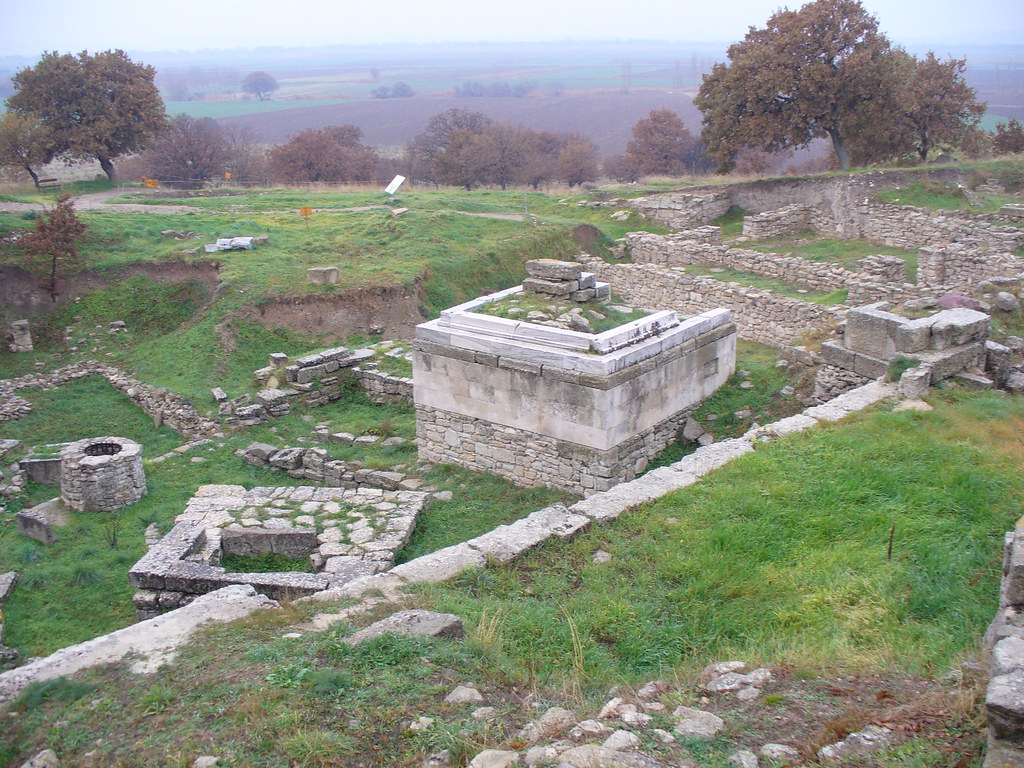
Troy walls and landscape: photo by QuartierLatin1968, 6 February 2007
At the time when their fall was certain --
On the ramparts the lament for the dead had begun --
The Trojans adjusted small pieces, small pieces
In the triple wooden gates, small pieces.
And began to take courage, to hope.
The Trojans too, then.
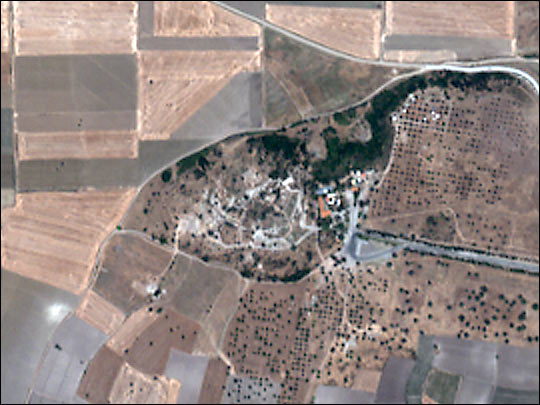
In den Tagen, als ihr Fall gewiß war --
Auf den Mauern begann schon die Totenklage --
Richteten die Troer Stückchen grade, Stückchen
In den dreifachen Holztoren, Stückchen
Und begannen Mut zu haben und gute Hoffnung.
Auch die Troer also.
Auf den Mauern begann schon die Totenklage --
Richteten die Troer Stückchen grade, Stückchen
In den dreifachen Holztoren, Stückchen
Und begannen Mut zu haben und gute Hoffnung.
Auch die Troer also.
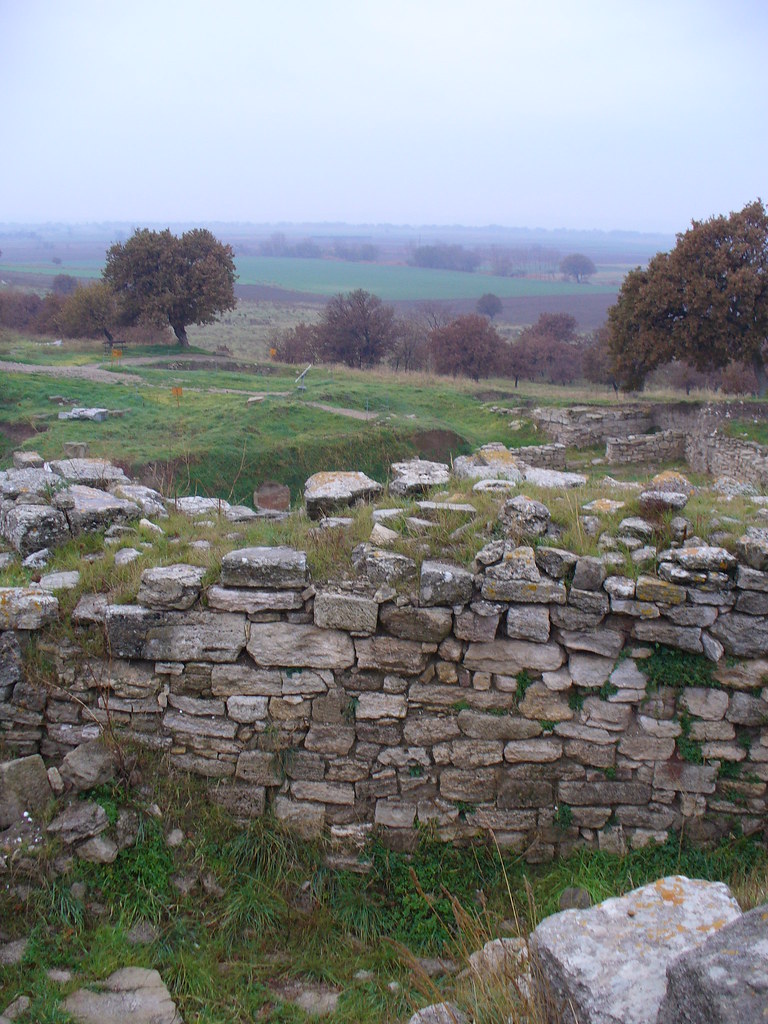
Troy walls and landscape: photo by QuartierLatin1968, 6 February 2007
Berlin, Hitler Youth clearing ruins after air raid: photographer unknown, 1943 (Deutsches Bundesarchiv/German Federal Archive)
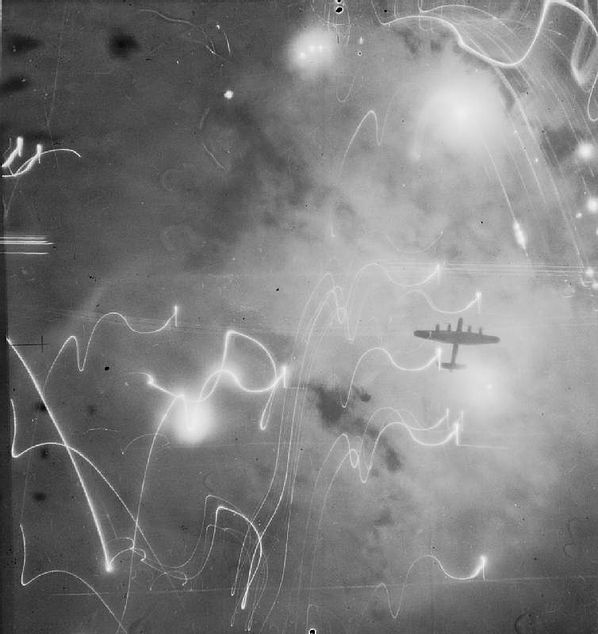
An Avro Lancaster of No. 1 Group, Bomber Command, silhouetted against flares, smoke and explosions during the attack on Hamburg, Germany, by aircraft of Nos. 1, 5 and 8 Groups on the night of 30/31 January 1943. This raid was the first occasion on which H2S centimetric radar was used by the Pathfinder aircraft to navigate the force to the target. The pilot of the photographing aircraft (Lancaster 'ZN-Y' of No. 106 Squadron, based at Syerston) was Flt Lt D J Shannon who, as a member of No. 617 Squadron, took part in Operation CHASTISE (the "Dams Raid") during the following May (Imperial War Museum)

Hamburg, destruction after British air raid, firefighters battling the conflagration, 24 February 1943: photo by Walther
(Deutsches Bundesarchiv/German Federal Archive)

Destruction of the port facility, Free and Hanseatic city of Hamburg, more than 50% destroyed in British-American bombing raids, especially those of July-August 1943: photographer unknown, 1948 (Deutsches Bundesarchiv/German Federal Archive)

Hamburg, view of the ruins near the Church of St. Michaelis, showing destruction after bombing attacks: photographer unknown, c. 1943-1945 (Deutsches Bundesarchiv/German Federal Archive)
Bertolt Brecht: Bei der Lektüre eines spätgriechischen Dichters / Reading a Late Greek Poet from Buckower Elegien / Buckow Elegies, July/August 1953: English version by Michael Hamburger in Bertolt Brecht: Poems 1913-1956, ed. John Willett and Ralph Manheim with the co-operation of Erich Fried, 1976
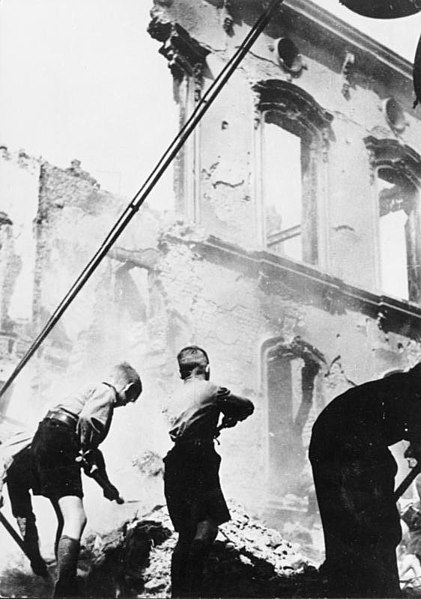

Tom,
ReplyDelete"On the ramparts the lament for the dead had begun--"
A great shock here, to go from the stones of Troy in such bucolic green fields to blackened walls of burned out buildings in Hamburg. We once took an overnight ferry from Harrige to Hamburg, harbor there cleared of all such wreckage as one sees here, hard to believe such things can happen, and do still happen, alas.
5.10
first grey light in sky above blackness
of ridge, waning white moon by branches
in foreground, wave sounding in channel
compared to which, position
the figure determined
sitting up, a ripened plant,
small head on a stalk
grey white of fog against top of ridge,
shadowed green pine on tip of sandspit
This Brecht poem extends a historical conversation begun by C.P Cavafy in the poem posted yesterday, Trojans.
ReplyDeleteIt's been shown that Brecht's version differs from Cavafy's in some crucial points. And it's been suggested on strong evidence that this sea-change between versions occurred not because Brecht misunderstood Cavafy, but because the German translator on whose version he was relying had misunderstood the Greek poet's meaning.
Helen Varapoulou, in New Essays on Brecht (2001), proposes that with this re-working the German poet transforms an "elegy-oriented, reflexive poem into a scene".
That would be part of Brecht's ongoing project to inject the dramatic gestus into the poetic landscape.
This series has been inspiring at a time when inspiration is sorely needed. For me it is an antidote to "throwaway" everything -- words spoken for public consumption, tricked-up images, and everything else daily pasted on surfaces that is either pasted over the next day or just deteriorates. Thank you. Curtis
ReplyDeleteTom, Is Hope then genetically encoded in us, a part of the condition we call human? Or is what we call hope our so very human refusal to see the situation as it is and for what it is? Accepting truth doesn’t come easy to us. Brecht finds the Trojans making small adjustments to the very gates that, in a moment of guileless optimism, they will swing wide to admit the gift horse that will undo them. Had they possessed deck chairs, these too they would have adjusted. I can see Priam on the ramparts, ten years into the seige, surveying the host of Greek invaders, and saying, ‘We’ve got ‘em now, boys. Right where we want ‘em.’ ‘The Trojans too, then.’
ReplyDeleteThe cut line for the fifth photo notes—as though it were important—‘This raid was the first occasion on which H2S centimetric radar was used . . . to navigate the force to the target.’ Poor Menelaeus navigated by the stars to reach ‘the ringing plains of windy Troy’ and go mano a mano with the ‘enemy.’ Bomber Harris used radar to accomplish the same ends at Hamburg, to reduce a city of some hundreds of thousands to rubble and its inhabitants to tiny, scattered bits of flesh. We accomplish the same ends today using drones controlled remotely from the safety of air-conditioned cubicles. This is progress, and it blinds us even as we devolve.
The conjunction of the misty green and brown fields of Troy, as gentle and fertile as the Cotswolds, for which I first mistook them, with the ruins of Hamburg from the air, which evoke a honeycomb attacked with a hammer -- it makes me think of Sandburg:
ReplyDelete"Two years, ten years, and passengers ask the conductor: What place is this? Where are we now?"
I wonder if there is any myth for our times and all the devastation we will leave behind. Troys of one kind or another. Or just some kind of insanity. I teach this open class every so often, and there's a kid in there who tells me there is a breed of reptilians that interbred with humans--they have no souls or hearts and they are to blame for the terrible events in history.
ReplyDeleteI just thought you should know that . . .
Stand in the trench, Achilles,
ReplyDeleteFlame-capped, and shout for me.
I'd never until now considered the echoing effect, the repetitive small pieces, of rubble, of which bombs are only a cause amongst so very many.
ReplyDeleteWere Bomber Harris to have been determined by DNA examination of exhumated remains to have been part reptile, much would become clear.
ReplyDeleteWould we prefer to be guided by robots or by reptiles?
A combination of the two?
The deck chairs, yes.
Puts me in mind of a comment made by the actress Daryl Hannah, some years back, intended apparently to exculpate her from the implied guilt (responsibility, is that the word?) that might have gone with owning and operating a fleet of race cars on the European circuit, that at least five (I believe it was) of the twelve cars in the fleet were hybrids.
Every little bit of carbon not emitted provides a good excuse for emitting the next umpteen tons.
And so by these little halo-growing activities we float on up to heaven in our Priuses, while Troy burns.
Small pieces, small pieces.
One hopes the nearly-lethal VW Jetta employed in lately reducing me to a sniveling ruin was at least getting good gas mileage.
But who will ever know about that, as it, along with the traces of my person imprinted thereto, has doubtless been spirited away, farther from the scene of the action than Troy IX was from Troy VII.
But eventually there comes or shall come the point at which, as suggested in the Exit Link which no one bothered with, at the beginning of this series of posts, there remain no Troys left to burn.
Just the rocks and the fossils and the occasional reptiles... and of course the memory of the Red Anger in the Burning Eyeballs of Achilles.
No wonder NFL football is so popular, with its bounties upon heads & c. Sublimation and displacement were always just blood sport in disguise.
Stand in the trench, Achilles,
Flame-capped, and shout for me.
"Two years, ten years, and passengers ask the conductor: What place is this? Where are we now?"
Ok, forgive my head injury logic, but memory now clears sufficiently to give Daryl a bit of a break.
ReplyDeleteThose biodiesel/ethanol cars of hers seem to have been put to pasture.
The resale value it seems is not so hot, either, even though the 1979 Trans/Am appeared in that ultimate bloodsport fantasia Kill Bill.
Pieces, pieces. Shouldn't the Kill Bill reverse charisma be worth a few carbon tradeoff points?
Still it's obvious that Daryl's heart pumps warm blood, that she is neither reptile nor bot, that she hugs a green tree and saves a wet whale and puts her tight body in the way of a drill rig, and that at least two of her homes are Off the Grid, and that you can pick up her spent bio-diesel El Camino for a virtual song.
Believe it.
In Troy the only celebrity dame really was Helen, and whatever else may have been said about her (well, obviously a lot was said), she was pretty certainly way, way off the grid.
But back then the whole concept of celebrity and in particular of celebrity genealogy was somewhat different.
For instance, Helen was not known to have come from a family of tugboat and barge entrepreneurs.
But pieces are pieces. And if Bomber Harris had been off the grid, how much more pleasant for the hundreds of thousands torched, asphyxiated, and drowned in the unquenchable white phosphorous flames?